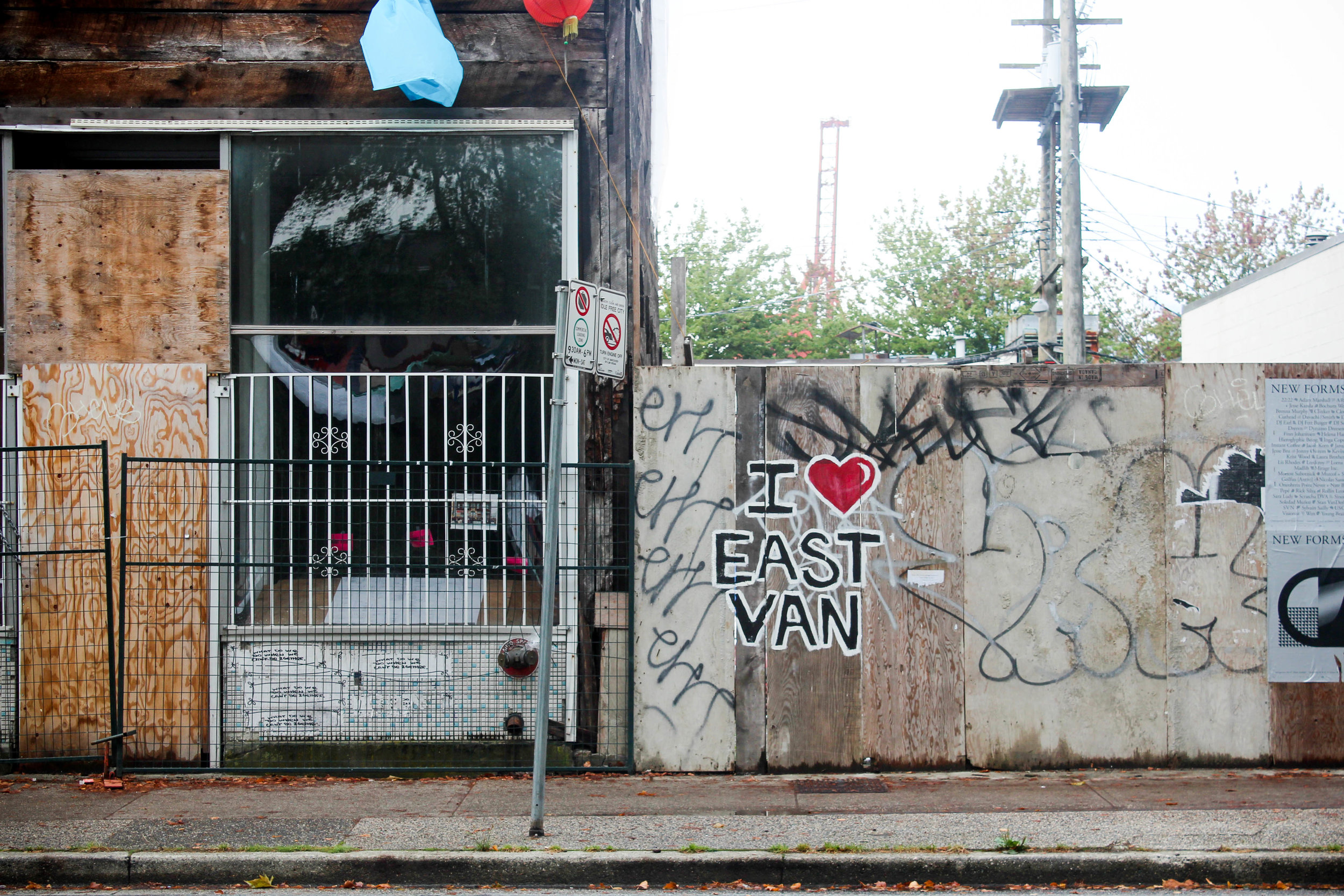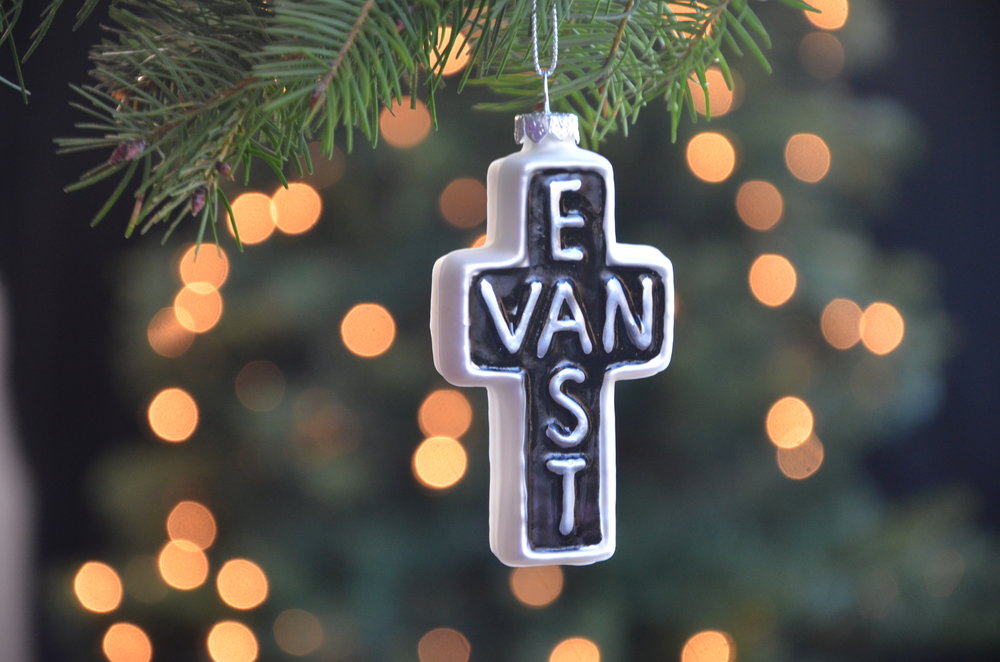Rhonda Nowak loves Christmas ornaments. She’s got a collection of ornaments from family trips — a Santa in a New York City taxi cab, a San Francisco street car — but she wanted something that represented her home of Vancouver.
“There weren’t really any ornaments reflected of our home city, so I wanted to do a line of iconic Vancouver symbols,” said Nowak, who moved to Vancouver from the Interior in the 1990s.
Nowak chose to live on the city’s east side because it was more affordable. This was the historic home of the working class and many immigrant groups: Europeans like Germans, Italians and Greeks arrived with post-war waves of migrants, and a boom of newcomers from Asia beginning in the late-1960s touched long after. East Vancouver was also more left-leaning, with hubs of counterculture blossoming in the 1980s.
When Nowak started Vancouver Christmas Ornaments, her most popular design represented that part of the city: the East Van cross.
The cross has “east” spelled from top-to-bottom and “Van” from left-to-right, with the two words sharing the letter A. The symbol dates back at least to the late-1940s, and over the decades popped up as graffiti on grocery store exteriors and emblems inked on denim jackets with black marker. In 2010, the cross was solidified as a local icon when city hall commissioned artist Ken Lum to create a 57-foot LED cross that now shines over the intersection Clark Drive and East Sixth Avenue.
“It’s pride of place,” Nowak said. “People just love the symbol and they want to display it. It’s particularly interesting at my church. Everybody wanted the East Van cross! They saw it as a symbol of their faith as well. It kind of bridges any cultural or social group because you have some really goth people that are buying it and posting it on their Facebook page, then you got Christians using it as well.”
But not all Vancouverites thought of the east side in a similar favourable light. In the past, many upper-middle class locals viewed the poorer east side with scorn.
“I knew people on the west side who would’ve never thought of living in East Van,” said Aaron Chapman, a civic historian and local writer. “It seems silly to say today, but it wasn’t that long ago that people on the west side had that attitude. People stuck to their part of town.”
Yet today, east Vancouver and its neighbourhoods are being embraced by residents, the real estate industry and lifestyle media alike. One reason is that it’s the more affordable half of Vancouver and why Nowak chose to move there in the first place. New businesses and developers are taking advantage of its affordability and getting into the market there, and there will soon be bang for their buck. But east side love is also growing because of the passion for history, tastes and values that it represents.
That attraction is playing out in a new way: products.
There are soy wax candles with scents that “celebrate that richness and diversity of local neighbourhoods” like Mount Pleasant and Strathcona (by the Vancouver Candle Company). There are East Van cross pendants, bracelets, rings and other jewelry (by Benée Rubin Jewellery). There are east Vancouver t-shirts, hoodies, caps and onesies for babies (by East Van Supply). And aside from the East Van cross and neighbourhood names, there are other local icons incorporated into products. There’s a Vancouver Special India pale ale, named after a common type of east Vancouver house, and a Dude Chilling Pale Ale, named after a popular art installation (by R&B Brewing). There are new businesses with East Van in their name too: East Van Roasters, EastVan Bees and East Van Brewing Company.
Authentic East Van

This commercial buzz raises a question: how did a historically stigmatized side of the city achieve the kind of desirability and cool that people would want to buy a t-shirt with East Van on it?
Sociologists point to the desire for urban authenticity, an essence that is often applied to a place by newcomers.
This phenomenon is not unique to Vancouver. As manufacturing declined in older parts of cities like New York, Portland, London, Melbourne and Shanghai, young creative and countercultural types were drawn to live there.
“Where their parents’ generation saw dirt and danger in the asphalt jungle, young city dwellers found beauty in the tumble down and excitement in the rough,” wrote urban sociologist Sharon Zukin.
These new urbanites didn’t want opulent areas; they wanted places that were lived-in, unique and had an edge. Older urban neighbourhoods with working-class pasts, diversity and cheaper rents enticed them. Vancouver neighbourhoods that fit this criteria were Strathcona, Hastings-Sunrise, Mount Pleasant, Commercial Drive and, more recently, Mountainview, now dubbed “Fraserhood” by the wave of new residents and businesses.
Other old neighbourhoods in Canadian cities have their own products too. In Toronto, they are pushed with hashtags like #cityofneighbourhoods and #repyourhood, signaling what a Toronto Star article said was local merchandise being sold to locals. You can get a Parkdale toque, a Roncesvalle shirt or a scented candle inspired by The Annex. Are you from Calgary? How about using a tote that reps Bridgeland or Beltline?
Place brands are more than a geographic marker; they’re also a signal of certain values. Think of how products branded Brooklyn are associated with being artisanal, entrepreneurial, ethical and local.
The East Vancouver brand, like other historic urban areas, evokes similar values of urban authenticity.
“East Van pride as the idea of the blue-collar, hard-knuckle person is very much connected to its heritage over the years,” said historian Chapman, whose last book, The Last Gang in Town, looks at the history of East Vancouver street gangs.
“East Vancouver used to be occupied by dock workers, sheet metal workers, sanitation workers, people that worked in the lumberyards at False Creek… But it’s now home to web designers, interior decorates, and so on. A lot of those blue-collar jobs don’t exist anymore in the city; you gotta go south of the Fraser [River] and other parts of the province.”
Today, Vancouver is less affordable for lower income workers and immigrant newcomers to settle, many of whom are choosing the suburbs instead.
But these populations who once lived in the inner city have left their mark on how urban neighbourhoods are branded.
The Commercial Drive business society uses the word “authentic” itself, along with “quaint” and “culturally rich,” calling a visit an “experience.” The Mount Pleasant BIA says the area is “eclectic” and “weaves together a variety of cultures and economic backgrounds.” The East Village BIA, which covers a stretch around and along Hastings Street, takes its name from the New York neighbourhood known for counterculture and calls itself a “vintage neighbourhood with a progressive attitude” and says it’s dedicated to capturing the “real flavour” of East Vancouver.
East Vancouver products embrace this heritage as well. East Van Vodka by Odd Society is described as being for “the artists and artisans, the hardworking and the inspired… the proud and the quirky, the charming and misunderstood.” East Van Supply doesn’t emphasize glamour, but grit; their clothing features images like alleys and shoes hanging from power lines.
“It shows that even as the city changes, that East Van definition or East Van concept still has cachet to it,” Chapman said.
Using a recycled tote signals you’re environmentally conscious. Wearing an East Vancouver shirt or drinking an East Vancouver spirit might signal your pride of place, but it also associates you with the rough-and-tumble image of the inner city.
The power of place brands
Neighbourhood brands change over time as the neighbourhoods themselves change.
“It’s not necessarily a good or bad thing, but rather is a question of whose purposes are served,” said Jeffrey Masuda, a human geographer at Queen’s University.
“My motivations lie in the power of place names, specifically what might be lost along the way if we limit ourselves to reading the city exclusively along lines that are imposed upon us by people trying to make a profit, rather than writing the city according to the way we wish to live our lives. It’s what we do with the power of the brand that I’m most concerned about.”
A place brand may be used by the real estate industry for profit or by municipalities in local area plans to revitalize a neighbourhood.
There are also dangers, like “conflating a specific neighbourhood brand to a larger geographic area, or the opposite,” said Masuda.
For example, East Vancouver branding is concentrated around neighbourhoods in the north of the city rather than the south.
But place brands are also powerful tools for communities to share a neglected history or fight for the rights of marginalized groups.
“It’s a form of neighbourhood development,” Masuda said. “A way of writing about the city and living in the city that can have consequences that can be both either positive or negative, depending on whose interests are represented in the brand.”
Would a “Kerrisdale beer” or a beer with any other with west side neighbourhood branding by as popular as one that hails from the east side?
Probably not, says Aaron Chapman, “but it doesn’t mean that [west siders] aren’t happy with where they live.”
It’s representations that are more marketable that tend to get promoted more actively, and the neighbourhood flavour of the day in Vancouver seems to be the gritty east side.
“There’s always been something about the wrong side of the tracks, even though East Van isn’t the wrong side of the tracks anymore. The image of a tough, east sider will drift further and further into older people’s minds.”
But perhaps it’ll remain immortalized in a store near you. ![]()
















Tyee Commenting Guidelines
Comments that violate guidelines risk being deleted, and violations may result in a temporary or permanent user ban. Maintain the spirit of good conversation to stay in the discussion.
*Please note The Tyee is not a forum for spreading misinformation about COVID-19, denying its existence or minimizing its risk to public health.
Do:
Do not: